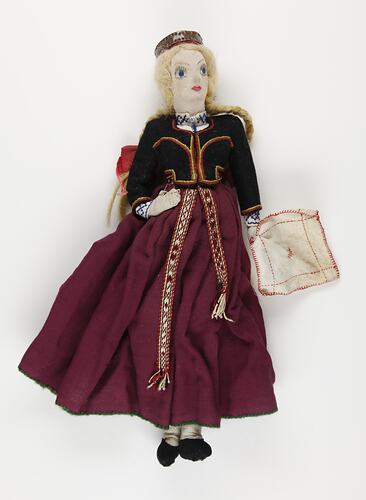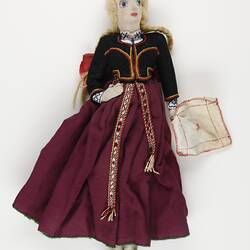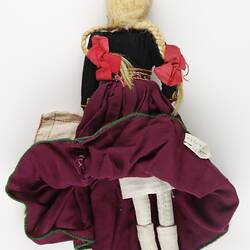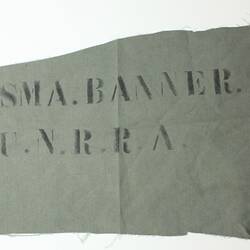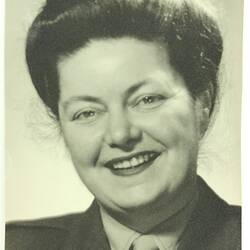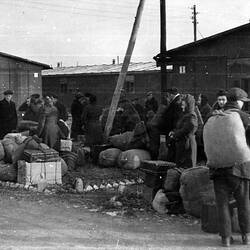Summary
Latvian female cloth doll collected by UN World War II displaced persons' camp worker Esma Banner between 1945 and 1951. It was created by a refugee in one of the displaced persons' camps in the US Zone in Germany.
Esma Banner worked in displaced persons' camps in the US Zone of Germany after World War II as an employment and welfare officer for the United Nations Relief and Rehabilitation Administration (UNRRA) and the International Refugee Organization (IRO), from 1945 to 1951. Esma was one of 39 Australians who went to Germany to assist with post-war repatriation and re-settlement of refugees displaced by the war. More than 1000 displaced persons' camps were established by the Allied Forces. Initially created as temporary processing centres, the camps became longer term sites of accommodation, employment, education and recreation for refugees who could not, or did not want to, be repatriated to their countries of origin.
Esma acquired examples of textiles, woodwork, leatherwork and other traditional craftwork from displaced persons' who made them from predominantly recycled and donated materials. While many traditional handcrafts were made out of necessity, others were made as a means to pass time, to express cultural identity, and occasionally to sell or exhibit. During the course of her time in Germany, Esma sent these objects home to her family in Australia.
Physical Description
Female doll wearing traditional Lativan folk costume. Doll is wearing cream coloured long sleeved shirt with blue embroidery and metal button and black embroidered jacket. She wears a long woven belt tied at her waist over a full length burgundy skirt with green hem. Doll is wearing white knee high socks and black shoes with a burgundy and blue garter (?) tied to her right thigh. Her hair is blonde and in plaits and she carries a handkerchief. Her head appears to be made from plaster covered in fabric with painted facial features and her body is stuffed from this same fabric. The word 'Latvia' embroidered on inner of skirt, and a label pinned to her skirt reads: No. 1847, Ru 173.
Significance
The Esma Banner World War II UN Worker Collection is an extensive and diverse collection of objects, documents, photographs and archival material which explores the experiences of an Australian woman working for the United Nations assisting in the relief and rehabilitation of millions of displaced people in Europe after World War II. Esma Banner served with the United Nations Relief and Rehabilitation Administration (UNRRA) and later with the International Refugee Organization (IRO) at displaced persons' camps in Germany from 1946 to 1951. She was one of fewer than 40 Australians employed by UNRRA and IRO during this period.
This collection recounts the often untold story of immigration from the perspective of a migration worker and enables the documentation of many themes relating to post World War II migration including life in the displaced person camps, international refugee management, creativity and cultural maintenance, and the political complexities of post-war resettlement. Of particular note are the craft items created by refugees living in displaced persons' camps. This collection holds a variety of men's and women's work, thus providing a significant insight into life within the camps. These objects also serve as valuable examples of cultural practices and traditional skills.
This collection and accompanying documentation presents a unique perspective of the post-World War II relief effort. Esma's diaries and letters in particular offer her personal insights and observations and demonstrate how civilians contributed to the reconstruction effort in Europe. In addition, these items add to the emerging collections of material describing women's involvements during times of conflict, as well as the larger narratives that illustrate Australia's wartime experience. After World War II hundreds of thousands of homeless, stateless or displaced people lived in camps before resettling in Western countries including Australia. This collection retains ongoing cultural relevance to these large migrant communities across Victoria and Australia. With the population of post-war displaced persons' survivors aging, the collection contributes to preserve their stories and experiences as part of a greater Australian migration narrative.
More Information
-
Collection Names
-
Collecting Areas
Migration & Cultural Diversity, Clothing & Textiles, Childhood, Home & Community
-
Acquisition Information
Donation from Helen Fitzgerald, 14 Mar 2012
-
Place & Date Made
-
Collector
-
Inscriptions
Label pinned to skirt: 'No. 1847, Ru 173' Inside of skirt: 'Lativa' (stitched)
-
Classification
-
Category
-
Discipline
-
Type of item
-
Overall Dimensions
210 mm (Width), 45 mm (Depth), 295 mm (Height)
-
Keywords
Latvian Communities, Displaced Persons, Displaced Persons Camps, Crafts, Carving, Dolls, World War II, 1939-1945, Handcrafts, Cultural Identity, National Identity, Wars & Conflicts, Cultural Traditions, Homecrafts, Migration & Settlement, National Costumes, Traditional Costumes, Clothing, Clothing Accessories, Textiles, Toys, Children's Play, Children's Clothing, Children, Children's Clothing Accessories, Refugees
